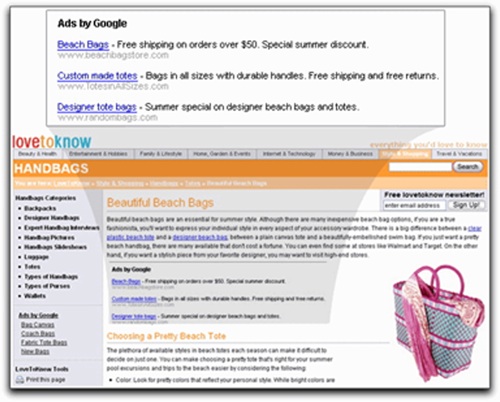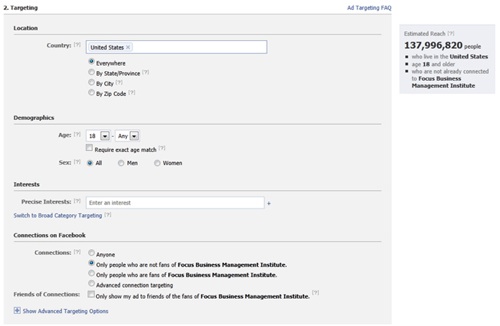Articles and News
WHEN IT PAYS TO BUY ADVERTISING ONLINE | January 11, 2012 (0 comments)

The final installment in The Centurion's exclusive Digital Marketing series discusses when it's beneficial to pay for advertising online, vs. using free methods of gaining exposure.
Las Vegas, NV--Up until now, the articles that I’ve written for this series have outlined ways to market your business online for free or very little monetary cost. The main cost is your time. But whether it is to target a specific audience or to ensure immediate display of your information, there are times when you will benefit from paid advertising. This article will outline the two most common paid advertising methods online: Google Adwords and the Facebook Ad network.
Google AdWords. One of the most common methods of quick advertising is to start using Google AdWords. It’s a great way to start showing on Google, but it can be a waste of money if you don’t do it right. It’s critical to know what your goals are, what your target market will be, and what items you are going to try to ‘sell’ before you start an AdWords campaign. Google has an excellent education section that discusses AdWords and how it can be used. Much of the information below is from the Google AdWords website.
The key to successfully using paid advertising is to hyper-target your niche market. By this, I mean that you need to make sure that if you service the northeast Buffalo, NY area, you need to adjust your advertising settings so that you ads only show to people who are in the northeast Buffalo, NY area, not all of NY or all of Buffalo. If you don’t hyper-target, you will waste your money on clicks from people who are not in your area.
Many jewelers might ask, “why such a narrow target? Isn’t this a borderless world and don’t I want people from outside the area to see my ad?”
For pay-per-click advertising, no. With the free online marketing tools we’ve discussed in prior articles, yes--but not for paid advertising. We’ve found that unless you are an Internet retailer—which is a very different business—it’s better to target your paid advertising only to local people.
Most people do their pre-shopping research online, but when it comes to actually making a jewelry purchase, they still tend to come into the store. That means someone who isn’t in your immediate trading area may click on the ad—which you then pay for—but they aren’t likely to come make a purchase.
Where Your Ads Appear. Where your ads will appear depends on the types of ads you have. Any type can reach millions of potential customers around the globe. There are three kinds of ads available in AdWords:
- Ads with keywords: These can appear on Google search results pages and the Google Network, which includes the Search Network and Display Network.
- Ads with placements: You can select where in the Google Display Network you'd like your ads to appear. For example, if you sell baseball bats you could target your ads on sports-related websites (ESPN, MLB, etc. – if they permit Google Ads). The system will let you know what sites are available and what size/type ads can be run there.
- Ads with mobile device targeting: Ads will be eligible to show on high-end mobile devices, such as iPhones or Android devices, and on mobile apps. This includes tablet devices.
Now let's look at the types of ads in more detail.
Ads with keywords. When you use keyword advertising, you select a set of keywords related to the product or service you wish to advertise (ex: engagement rings Georgia, engagement rings Atlanta, engagement ring, wedding rings, diamond rings, diamond jewelry). Your keywords should be focused, but they can include broad items (like engagement rings), because you are going to hyper-target your ads by geography. The advantage of adding specificity to your keywords is that you will have lower prices and lower competition for the very specific searches. Your ads from ad groups with keywords can appear on Google search results pages and the Google Network. The Google Network is the largest advertising network available online, reaching over 86% of Internet users worldwide, and includes millions of independent websites as well as Google properties such as Google Maps, Google Images, Gmail, and more.
- Google: When someone searches online and enters words including your keywords, your ads can appear alongside or above the search results.
- The Google Network: This network includes the Search Network and the Display Network websites. Your ads can appear in many places on these two networks.
- The Search Network: Your ads may appear alongside or above search results, as part of a results page as a user navigates through a site's directory, or on other relevant search pages. Google’s global Search Network includes Google Maps, Google Product Search, and Google Groups along with entities such as Virgin Media and Amazon.com.
- The Display Network:Your text, image, rich media, and video ads can appear across YouTube, Google properties such as Google Finance, Gmail, Google Maps, Blogger, as well as over one million Web, video, gaming, Display Network partners, and mobile display partners. AdWords ads on the Display Network are targeted to the content and URL of each page.
Here's an example of ads on a Display Network site. You can see how the ads--for bags and totes--are targeted to the content of the page:

Gmail, Mobile Devices and Tablets. Advertising with AdWords can also show in Gmail accounts, mobile devices, and tablet devices. Although this is a desired market to get to, due to the increase mobile search, it is recommended for more advanced users.
Where to Start. The most common starting point for AdWords using the Ads for Keywords is Pay Per Click (PPC) method. This generates the text ads that show above and next to the organic search results (the PPC section is shaded pink in the image below, the organic search results are white) and only charges the advertiser when the ad is clicked. The other method is Pay Per Impression, meaning that you pay each time your ad shows, whether or not anyone clicks on it.

The big benefit to keyword advertising is that you can hyper-locate your niche. By choosing your select keywords, you can insure that your ads will only show when someone searches for specific terms. Additionally, you can geo-locate your ads. This means that you can drill down to the cities/towns where you want your ads to show. So, if you choose “diamond jewelry” (which is a broad term), and only select “Altoona, PA” as your geographic area, it means that only people with IP addresses that are identified as Altoona, PA addresses will get this ad shown to them. Again, as discussed above, narrow your field to your immediate trading area. In some parts of the country, this might be a 150-mile radius; elsewhere it might be only 5 miles. But your target should be the area where someone would be willing, on a regular basis, to drive to your store.
Keywords. As discussed in an earlier article, you are going to use the Google Keywords tool to determine the best keywords to target. By selecting the keywords with the highest number of searches and the lowest amount of competition, you are maximizing your AdWords dollars. If you have a keyword that you want that has heavy competition, you can focus on using your Adwords for the less competitive keywords and use the other search engine marketing tools we discussed to try to capture views for the more competitive ones.
Geography. When you set up your campaign you will go into the geography section and go down level by level until you reach the geographic area that contains your clients. You can drill down from country to state to city to town to be sure that you are only reaching the computers of clients in your trading area. This is a critical step to be sure that you can manage your budget.
Budget. Each campaign has a budget that you set. You can set the budget to cap on a monthly basis or a daily basis. You can then determine whether you want Google to show your ads evenly (they will spread out your ads during the day to hit your spending goal), or whether you want to show all of your ads as quickly as possible until you hit your goal. There is no one answer that is correct related to your desired speed of delivery of your ads or your specific day-parts. If you see a pattern of conversions at one time over the other, then you can work to adjust your ads to focus on those times.
After you know your total budget, you can then determine the maximum amount you want to spend per click and apply that to all keywords. By checking the “Traffic Estimator” tool that is embedded in AdWords, you can determine how much traffic you should expect based on your keywords and your budget. If there are some keywords that you think are more important than others, you can even go down to the keyword level and adjust the cost per click.
Facebook Advertising
Just as Google found a way to monetize their tremendous website traffic, Facebook is now looking to monetize its platform via Facebook Ads. You will see ads on the right side of your Facebook wall/news feeds page.
The same basic concepts apply to Facebook advertising as AdWords: you need to hyper-target your audience to maximize your spending dollars. Facebook allows you to select potential targets (Facebook pages/profiles where your ads appear) by a combination of country, state, city, or zip code, age, gender, or interests. You can also add conditions to your ads to target people who are (or are not) already friends or “like” your page.
You also can select additional criteria that get very granular. Click on the ‘show more advanced targeting’ link to see these conditions. With the Advanced Connection Targeting, you can even specifically target people who are friends of certain sites, or friends with certain people/groups that you have in your network (think about targeting people who like your page and advertise that “Your friends like us – How about checking us out!”). It’s very, very targeted advertising.

Just like AdWords, you can set your budgets and caps.
If you are interested in brand building (name awareness), you may just want to go with a cost/impression (you want as many people to see your name and logo as possible and you aren’t really concerned with whether they click or not), or you can go on a cost-per –click. The system will give you a suggested cost per click, but go lower and start testing with lower numbers. If you have no response, increase your cost per click.
Remember that as long as you hyper-target your audience using very specific keywords and/or locations, the higher you can go on the cost per click because these are going to be your key potential clients.
As I discussed in the Facebook section – Facebook is a personal interaction tool and, in my opinion, is not quite ready for prime time when dealing with driving commerce. Before you spend money on Facebook ads, think about how many Facebook ads you have clicked on over the past 60 days and then decide if it is worthwhile. Personally, I don’t click on Facebook ads, so I’m not a fan of this type of advertising, but it could be worth a trial run to see if you can gain some clicks.
Monitoring Your Results. With AdWords or Facebook (or any other advertising you do), you should have some way of measuring the results. When a viewer clicks on an ad, it should go to a page on your site that is only linked to that ad. Consider having a data capture page that asks for their contact information, and have each of those pages tied only to the AdWords or Facebook advertising. That way you can see exactly how people found you. Also, don’t be afraid to ask new clients how they found you when they are in your store.
Jeffrey W. Arnold is a business consultant for Focus Business Management Institute an industry leader in retail jewelry consulting. Arnold has helped increase the profitability of numerous companies, ranging from start-ups to multi-billion-dollar entities. He now conducts social media and Internet marketing seminars for retail jewelers and leads the marketing initiatives for Focus. For more information on Focus and how they help increase profitability for independent jewelers, visit www.FocusBMI.com







